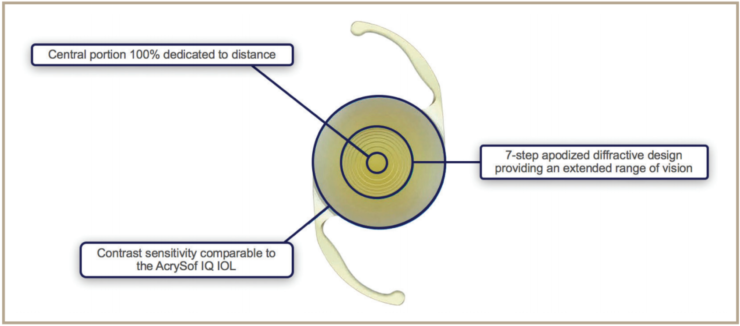While the fundamental principles of cataract surgery have not changed much over the years, the expectations for quality outcomes has never been higher. Patients undergoing a cataract operation with IOL implantation are seeking postoperative vision that that will allow them to resume the same hobbies and activities they participated in before surgery—and if the stakes are high for patients choosing a monofocal lens, they are even higher for those opting for a presbyopia-correcting IOL.
Modern IOL designs are seeking to answer this conundrum. The ReSTOR 2.5+ with ActiveFocus Optical Design (Alcon) is a hybrid IOL with a central optic dedicated to distance. It is built to deliver more energy distribution for distance vision than other multifocal IOLs and lenses intended to provide a full range of vision; yet, it also does not sacrifice the quality or quantity of distance or intermediate vision that patients can achieve.
“The center optic is a refractive optic that focuses the light energy for distance vision. Therefore, the patient who has this lens for presbyopia correction not only gets presbyopia correction, but they also have the optics of a monofocal lens distance IOL,” explains Bonnie Henderson, MD, of Ophthalmic Consultants of Boston.
Innovative Design Engineered for Performance
In a recent survey,1 anterior segment surgeons who specialize in implanting presbyopia-correcting IOLs were asked what factors they considered to be most important for providing patients the vision they want. Not surprisingly, high patient satisfaction and delivering on patient expectations were the top answers. However, what may be surprising to some is that many surgeons also listed the ability to yield high-quality distance vision as extremely important—and in fact, optimized distance vision was of greater importance to surgeons than any other vision attribute such as near and intermediate focus.2
For individuals with presbyopia, attaining optimal distance vision may be important for several reasons. For instance, the visual compromise at near vision may leave them unwilling to sacrifice additional visual ability in other vision zones. According to Dr. Henderson, many patients with presbyopia have expectations to use their postoperative vision to participate in activities that require distance vision. She said that many of her cataract patients are asking for vision that will help them maintain their active lifestyles and activities, including an ability to view smartphones and computers in different viewing zones.
Henderson says this is a feature the new monofocal-multifocal lens is designed to deliver upon. In a study comparing modular transfer function (MTF) of different IOLs, the hybrid lens achieved the greatest MTF score, suggesting its optics provided the best optical image quality for distance vision.3
“The ReSTOR 2.5 with ActiveFocus Optical Design is different than the other multifocal lenses, because it really allows the patient to have both the benefit of uncorrected near vision but also with enhanced distance vision,” Dr. Henderson says.
An additional feature of the hybrid lens is a 7-step apodized diffractive design for efficient light management across all distances of vision (Figure). In conjunction with the central optic, this feature extends depth of focus—but, because the lens has negative asphericity, it has a lower risk of inducing visual symptoms such as glare and halo than other lenses on the market. Finally, the new lens has a similar contrast sensitivity profile as the existing Alcon lens technology.3,4

Image courtesy of Alcon
FIGURE . The hybrid lens is a 7-step apodized diffractive design for efficient light management across all distances of vision.
“The beautiful thing about the distance vision in patients with the ReSTOR 2.5 with ActiveFocus Optical Design is that there is no difference in their distance vision,” says Brandon Ayres, MD, of Wills Eye Hospital in Philadelphia. “In fact, it is on par with that of a monofocal IOL, so one of the largest advantages of this lens technology is that there is little to no concern about giving our patients uncompromised distance vision.”
Practical Applications
The hybrid lens is intended to give patients the best of both worlds: crisp distance vision with functional near vision. The range of vision achievable with this lens may serve to change how surgeons make IOL recommendations. In the past, patients seeking quality near vision may have had to sacrifice distance acuity with certain presbyopia-correcting IOLs. Other IOLs offered great intermediate vision but with compromise at near. To many surgeons, this new lens reduces the need to ask patients to compromise the vision they want to achieve after cataract surgery.
Jim Katz, MD, of the Midwest Center for Sight, Chicago, suggests starting the process of IOL selection by asking the patient what activities and hobbies he or she participates in. Then, with that knowledge in mind, recommend an IOL likely to provide vision that will support that desire.
“When we try to determine which type of lenses to introduce to the patients, we ask them questions about their visual needs for intermediate, as well as near. It turns out, the most important part of the vision to the patients is their distance vision, and the quality of the distance vision,” Dr. Katz says.
While the new hybrid lens provides most patients with satisfactory vision at near, intermediate, and distance, surgeons still have many options to fine tune the optical system toward the visual goals of their patients. For example, if this lens is implanted in the dominant eye during the first surgery, the patient can receive a similar implant in the fellow eye during the second operation if he or she is satisfied with the range of vision as measured at 1-week of follow-up. However, if additional near acuity is desired, an AcrySof IQ ReSTOR +3.0 D IOL (Alcon) can be used in the fellow eye to provide +2.5 D add power at the IOL plane versus +2.0 D add power at the IOL plane with the ReSTOR 2.5 with ActiveFocus Optical Design.
The blended vision of a ReSTOR 2.5 with ActiveFocus Optical IOL with an AcrySof IQ ReSTOR +3.0 D IOL will yield about 2 extra lines of functional near vision.3
Expanding Eligibility
New IOLs are equipping surgeons with a greater ability to match patients with a lens that fits their lifestyle. Still, managing expectations for postoperative vision remains important. While spectacle independence is a likelihood following implantation of a ReSTOR 2.5 with ActiveFocus, some patients may still need spectacles when performing near tasks.3
“The introduction of the ReSTOR 2.5 with ActiveFocus Optical Design has really expanded my patient base for the people who can and should have multifocal lenses,” Dr. Henderson says. “I find that this particular lens has allowed me to consider patients who really want sharp distance vision but still want a multifocal optic.”
1. Survey of 90 surgeons who implant a presbyopia correcting IOL. Brand Health Tracker. Conducted December 2015 and July 2016.
2. Nuijts RM, Jonker SM, Kaufer RA, et al. Bilateral implantation of +2.5 D multifocal intraocular lens and contralateral implantation of +2.5 D and +3.0 D multifocal intraocular lenses: Clinical outcomes. J Cataract Refract Surg. 2016;42(2):194-202.
3. Vega F, Alba-Bueno F, Millán MS, et al. Halo and through-focus performance of four diffractive multifocal and intraocular lenses. Invest Ophthalmol Vis Sci. 2015;56;3967-3975.
2. Alcon Data on File. TDOC-0052151 (11 Apr 2016).
Drs. Ayres, Henderson, and Katz serve as consultants to Alcon.


